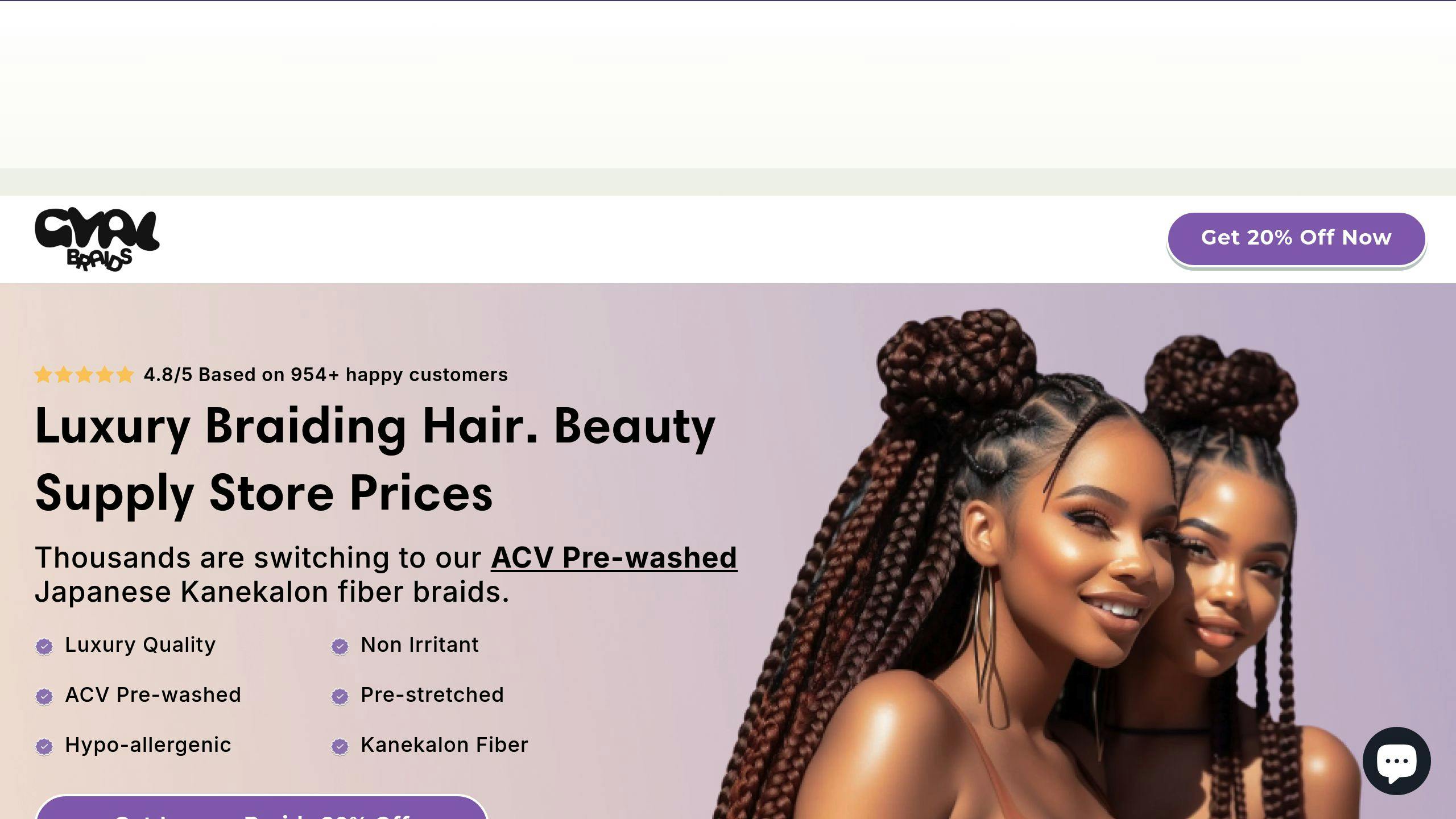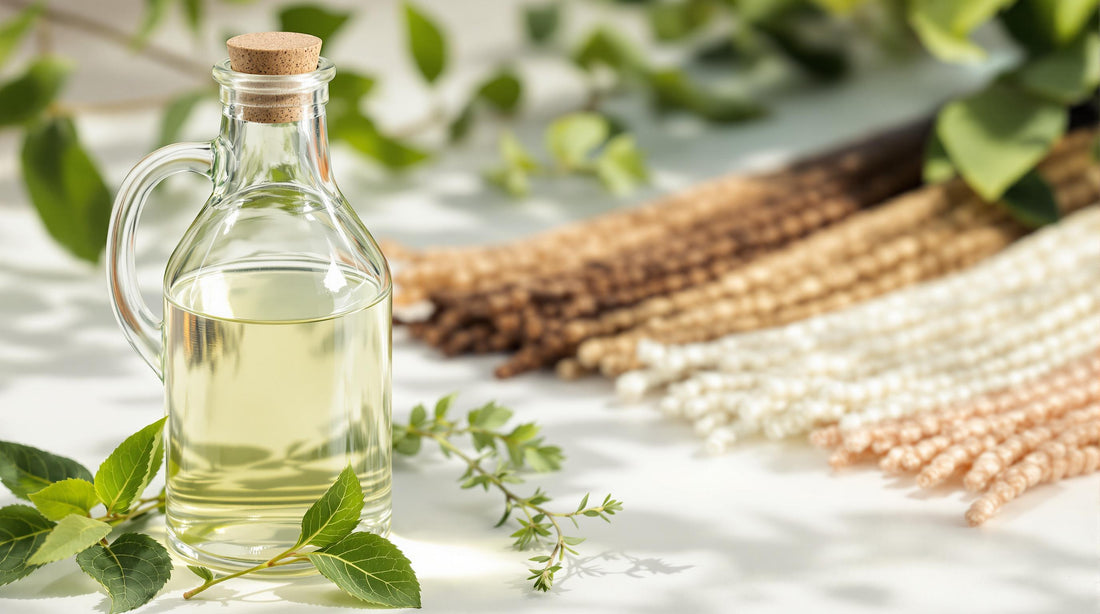Tired of itchy, uncomfortable synthetic braids? A vinegar rinse can solve that. This simple treatment removes chemical residues, balances your scalp's pH, and improves the texture of synthetic braiding hair. Here's what it does:
- Eliminates chemical coatings that cause irritation.
- Balances scalp pH to reduce itching.
- Softens hair fibers for easier styling.
- Reduces scalp irritation from synthetic materials.
- Prevents bacterial and fungal buildup during extended wear.
For a hassle-free alternative, pre-treated hypoallergenic braiding hair like Gyal Braids skips the need for a vinegar rinse entirely. Whether you rinse or go pre-treated, keeping your scalp healthy makes all the difference for comfortable braids.
How to Rinse and Soak Braiding Hair with Apple Cider Vinegar
How Vinegar Rinses Work
The main ingredient in vinegar, acetic acid, helps improve synthetic braiding hair and scalp health thanks to its chemical properties. It breaks down the chemical coatings found on synthetic hair while also supporting a healthier scalp environment [2].
Because vinegar's acidity is similar to the scalp's natural pH, it helps reduce common problems like itching and irritation. Plus, its antibacterial qualities help stop the growth of bacteria and fungi, which is especially useful for long-term protective hairstyles [3].
When used on synthetic braiding hair, vinegar offers several advantages. It smooths the hair cuticle, boosting shine and texture while cutting down on tangling and frizz. This makes the hair easier to manage and more comfortable to wear, enhancing the braiding experience overall [2].
To apply it correctly, vinegar should be diluted with water to avoid irritating the scalp. This mixture effectively tackles common synthetic hair issues while keeping the scalp healthy during the protective style's wear [3].
Now, let’s dive into how vinegar rinses make synthetic braiding hair more comfortable and user-friendly.
1. Eliminates Chemical Coatings
A vinegar rinse is a simple way to strip chemical coatings from synthetic braiding hair. The acetic acid in apple cider vinegar (ACV) breaks down the chemical build-up, helping to reduce irritation and allergic reactions.
Here’s how to do it effectively:
| Step | Instructions | Duration |
|---|---|---|
| Preparation | Mix 1 part ACV with 3-4 parts warm water | 1 minute |
| Soaking | Submerge synthetic hair, keeping bundles intact | 15 minutes |
| Final Rinse | Rinse thoroughly with lukewarm water | 2-3 minutes |
Using raw apple cider vinegar is ideal for tackling residues. This process helps create a safer, more comfortable base for protective styles by removing irritants.
If you prefer to skip this step, pre-treated synthetic hair brands like Gyal Braids are a convenient option. These products are hypoallergenic and free from harsh chemicals. Even so, a diluted ACV rinse can still be beneficial for scalp care during wear.
Vinegar rinses are a natural and effective way to prepare synthetic hair, making it more comfortable for your scalp. With chemical residues gone, you’re ready to explore how vinegar rinses contribute to a healthier scalp environment.
2. Balances Scalp pH
Synthetic braiding hair can throw off your scalp's natural pH, leading to irritation. A vinegar rinse helps restore this balance, promoting a healthier scalp.
Here’s a quick guide to vinegar rinse concentrations and their purposes:
| Vinegar Solution | pH Level | Best For |
|---|---|---|
| Strong (1:2 ratio) | 3.0-3.5 | Removing heavy chemical buildup |
| Standard (1:3 ratio) | 3.5-4.0 | Routine scalp care |
| Gentle (1:4 ratio) | 4.0-4.5 | Sensitive scalps |
To keep your scalp in check, use a vinegar rinse weekly. A spray bottle works well to apply it evenly without soaking your hair. If you have a sensitive scalp, consider hypoallergenic hair brands like Gyal Braids, paired with a gentle vinegar rinse.
Stick to raw apple cider vinegar for the best results. No need to rinse it out - the smell fades as it dries, leaving your scalp balanced and refreshed.
Now that your scalp is in good shape, let’s dive into how vinegar rinses can improve the texture and manageability of synthetic braiding hair.
sbb-itb-2cead6a
3. Improves Hair Feel
A vinegar rinse can work wonders on synthetic braiding hair by softening rough fibers and removing leftover residue from manufacturing. This process not only smooths the surface of the hair but also makes it easier to handle and gives it a more natural appearance.
Here's how vinegar helps with texture:
- Smooths synthetic fibers for a softer feel
- Removes residue left from production
For the best results, adjust the vinegar-to-water ratio based on the type of hair you're treating:
- Standard synthetic hair: Mix 1 part vinegar with 3 parts water.
- Pre-treated hair (like Gyal Braids): Opt for a gentler mix, such as 1:4 or 1:5, to clean the hair without altering its existing texture.
Make sure to let the hair air-dry completely before braiding to maintain its texture. Softer, smoother hair not only makes styling easier but also improves comfort during the braiding process.
Now that your hair is prepped and feeling great, let’s dive into how vinegar rinses can help reduce irritation and protect your scalp.
4. Reduces Scalp Irritation
Synthetic braids can sometimes lead to scalp irritation, showing up as itching, redness, or even bumps. A vinegar rinse can help ease these symptoms and provide relief, making it a helpful step for a more comfortable braiding experience.
The irritation is often caused by the chemical coatings on synthetic hair. A vinegar rinse neutralizes these coatings effectively. However, the success of this treatment depends on how it's applied and the time it soaks.
Here’s a quick guide to soaking synthetic hair for best results:
| Soaking Duration | Purpose |
|---|---|
| 15 minutes | Light cleaning |
| 1-2 hours | Standard treatment |
| 3 hours | Deep cleaning |
Preparing the hair properly before installation is crucial for avoiding irritation. Soaking synthetic hair in a vinegar solution creates a better base for long-term wear. For even less irritation, consider using hypoallergenic or pre-treated hair along with the vinegar rinse.
5. Prevents Scalp Problems
Using a vinegar rinse can help tackle common scalp issues caused by synthetic braiding hair. By removing bacteria and fungi, this treatment lowers the chances of infections, buildup, and irritation, especially during extended wear. Applying it before braiding is key.
| Treatment Type | Vinegar-to-Water Ratio | Recommended Use |
|---|---|---|
| Preventive Care | 1:3 | Before each new installation |
| Sensitive Scalp | 1:4 | For mild cleansing |
| Deep Treatment | 1:2 | For severe residue buildup |
"A vinegar rinse reduced irritation and is now essential in my braiding routine", says Chia from Just Peachy Co. [1]
For those with sensitive scalps, combining preventive measures is especially effective. Pairing pre-washed, hypoallergenic braiding hair with a vinegar rinse provides added protection against scalp problems.
To get the best results, ensure the vinegar solution is thoroughly applied to the base of each hair bundle to remove hidden residues. Along with balancing pH and soothing irritation, vinegar's cleansing properties make it a must-have step in preparing for braiding.
Benefits of Using Gyal Braids

If you're tired of the hassle of vinegar rinses for synthetic hair, Gyal Braids offers a convenient solution. These pre-washed, pre-treated braiding hair bundles are made from high-quality Japanese Kanekalon fiber and are ready to use straight out of the package - no extra prep needed.
What sets Gyal Braids apart is their thorough treatment process. The fibers are pre-washed, hypoallergenic, anti-bacterial, and chemical-free, making them a safer and more comfortable option. This eliminates the need for vinegar rinses, addressing common concerns like chemical residue, scalp irritation, and bacteria buildup.
| Feature | Benefit | Impact on Installation |
|---|---|---|
| Pre-washed Treatment | No chemical residue | Ready to use immediately |
| Hypoallergenic Fiber | Lower risk of irritation | Perfect for sensitive scalps |
| Anti-bacterial Properties | Helps prevent scalp issues | Promotes scalp health during wear |
| Chemical-free Processing | Natural feel and look | No artificial coatings or harsh additives |
For anyone with a sensitive scalp, Gyal Braids' hypoallergenic and chemical-free fibers minimize irritation while providing a soft, natural feel. Plus, the anti-bacterial properties help maintain scalp health throughout wear, solving a key problem that vinegar rinses are often used to address.
Another bonus? The pre-stretched design makes installation easier and results in a natural-looking finish. Whether you're a professional stylist or doing your braids at home, Gyal Braids save time and deliver quality, making them a smart choice for anyone seeking premium braiding hair.
Wrapping It Up
Using a vinegar rinse can make a big difference when it comes to the comfort and quality of synthetic braiding hair. It helps remove chemical residue, reduces irritation, and supports scalp health - making your protective style much more enjoyable.
"A vinegar rinse reduced irritation and is now essential in my braiding routine", says Chia from Just Peachy Co. [1]
If you're looking for an easier option, Gyal Braids offers pre-treated, hypoallergenic braiding hair. Made with premium Japanese Kanekalon fiber, it’s ready to use straight from the package - no vinegar rinse needed.
Whether you choose to rinse your hair or go with pre-treated options like Gyal Braids, keeping your scalp healthy is the key to a comfortable and irritation-free protective style.

